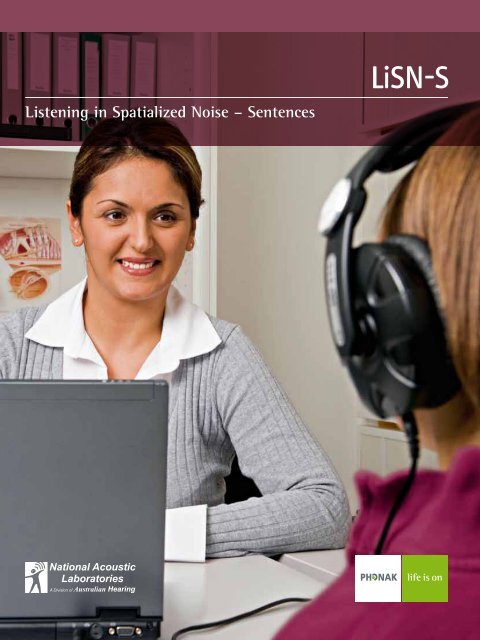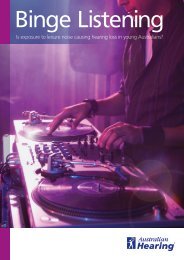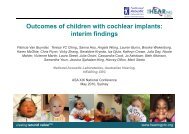What is LiSN-S? - CAPD at National Acoustic Laboratories
What is LiSN-S? - CAPD at National Acoustic Laboratories
What is LiSN-S? - CAPD at National Acoustic Laboratories
You also want an ePaper? Increase the reach of your titles
YUMPU automatically turns print PDFs into web optimized ePapers that Google loves.
L<strong>is</strong>tening in Sp<strong>at</strong>ialized No<strong>is</strong>e – Sentences
2<strong>Wh<strong>at</strong></strong> <strong>is</strong> <strong>LiSN</strong>-S?The L<strong>is</strong>tening in Sp<strong>at</strong>ialized No<strong>is</strong>e – Sentences Test,or <strong>LiSN</strong>-S, assesses the ability of children tounderstand speech when no<strong>is</strong>e <strong>is</strong> arriving fromdifferent directions.Understanding speech in competing no<strong>is</strong>e <strong>is</strong> aproblem commonly experienced by children withauditory processing d<strong>is</strong>order (APD). <strong>LiSN</strong>-S uses <strong>at</strong>otally new and ingenious way of testing thesechildren’s auditory skills.Test stimuli are presented under PC-connectedheadphones. Using advanced m<strong>at</strong>hem<strong>at</strong>icalalgorithms, a virtual three-dimensional acousticspace <strong>is</strong> cre<strong>at</strong>ed under these. By then moving thecompeting no<strong>is</strong>e from the front to the sides, <strong>LiSN</strong>-Stests whether children are able to make use ofsp<strong>at</strong>ial advantage.<strong>Wh<strong>at</strong></strong> the experts say ...“<strong>LiSN</strong>-S <strong>is</strong> an excellent example of a new gener<strong>at</strong>ion of well-designed andevidence based clinical measures of auditory-specific processing. <strong>LiSN</strong>-S tapsinto critical auditory processes th<strong>at</strong> are not evalu<strong>at</strong>ed by the ex<strong>is</strong>ting APDtest b<strong>at</strong>tery.”James W. “Jay” Hall III, PhD.Clinical Professor and Associ<strong>at</strong>e Chairof the Department of Communic<strong>at</strong>ive D<strong>is</strong>orders,University of Florida, Gainesville, Florida“<strong>LiSN</strong>-S adds a new dimension to the clinical assessment of AuditoryProcessing D<strong>is</strong>order.”Jennifer L. Smart, PhD.Ass<strong>is</strong>tant Professor, Towson UniversityDepartment of Audiology, Speech-Language P<strong>at</strong>hology,and Deaf Studies, Towson, Maryland“<strong>LiSN</strong>-S – a unique approach to the assessment of Auditory ProcessingD<strong>is</strong>orders.”Robert W. Keith, PhD.Adjunct Professor Department of Communic<strong>at</strong>ion Sciencesand D<strong>is</strong>orders College of Allied Health SciencesUniversity of Cincinn<strong>at</strong>i
3<strong>LiSN</strong>-S will support you in your clinical dec<strong>is</strong>ions and help youdetermine whether a child’s l<strong>is</strong>tening skills have improvedafter some form of intervention.Offered as a combined hardware and software package,<strong>LiSN</strong>-S compr<strong>is</strong>es a proprietary PC software program, specialhigh quality headphones and Phonak Soundcard. The softwarealso includes an Autom<strong>at</strong>ic Internet Upgrade Service: wheneverupd<strong>at</strong>es are available, the user <strong>is</strong> notified and upgrades canthen be downloaded free of charge. These upgrades willcompr<strong>is</strong>e of new fe<strong>at</strong>ures such as new language support, newnorms, new reports and extended d<strong>at</strong>abase functions.<strong>LiSN</strong>-S <strong>is</strong> easy to admin<strong>is</strong>ter,takes only 20 minutes and givesyou crystal clear results.The <strong>LiSN</strong>-S test <strong>is</strong> scientificallyrobust, very sensitive and offershigh test-retest reliability.Who developed <strong>LiSN</strong>-S?<strong>LiSN</strong>-S was developed by Dr. Sharon Cameron, a researchscient<strong>is</strong>t <strong>at</strong> N<strong>at</strong>ional <strong>Acoustic</strong>s Labor<strong>at</strong>ories (NAL) in Australia,and Dr. Harvey Dillon, NAL’s director. Both are highly respectedin the intern<strong>at</strong>ional scientific community for their innov<strong>at</strong>iveand outstanding contributions, and NAL itself <strong>is</strong> one of theworld’s leading research institutes. As the research div<strong>is</strong>ion ofAustralian Hearing, a Commonwealth Government Authorityunder the Department of Human Services, NAL undertakesscientific investig<strong>at</strong>ions into hearing, hearing habilit<strong>at</strong>ion andrehabilit<strong>at</strong>ion, and the prevention of hearing loss.The test’s inventor, Dr. Sharon Cameron, has applied the higheststandards of scientific rigor in designing and valid<strong>at</strong>ing <strong>LiSN</strong>-S.It <strong>is</strong> a model for how tests in th<strong>is</strong> area should be developed.Phonak, the exclusive worldwide d<strong>is</strong>tributor of <strong>LiSN</strong>-S, <strong>is</strong> proudand privileged to be associ<strong>at</strong>ed with NAL.Developed by NALD<strong>is</strong>tributed by Phonak
5Condition 4: Low Cue SRTIn condition four, the competing no<strong>is</strong>e uses the same voice asthe target speech and comes from in front of the child – thesame direction as the target speech.Th<strong>is</strong> fourth condition <strong>is</strong> the most difficult of the fourconditions as there are no sp<strong>at</strong>ial cues available and thetarget speech and competing no<strong>is</strong>es are very similar. Theresult of th<strong>is</strong> test <strong>is</strong> referred to as the child’s low cue speechreception threshold or ‘low cue SRT’.Speech signalNo<strong>is</strong>e fromsame voiceSp<strong>at</strong>ial AdvantageMoving d<strong>is</strong>tracting voices from the front to the sidesallows a child to make use of sp<strong>at</strong>ial cues. How much anindividual child benefits from th<strong>is</strong> movement <strong>is</strong> easilycalcul<strong>at</strong>ed, by measuring the difference in scores betweenconditions 2 and 4.Th<strong>is</strong> so-called ‘sp<strong>at</strong>ial advantage’ <strong>is</strong> calcul<strong>at</strong>ed autom<strong>at</strong>icallyby <strong>LiSN</strong>-S and <strong>is</strong> a highly sensitive indic<strong>at</strong>or.Children diagnosed with APD score very poorly in th<strong>is</strong>sp<strong>at</strong>ial advantage test.Talker AdvantageTo assess how well a child can differenti<strong>at</strong>e betweendifferent speaker voices and therefore understand speechin no<strong>is</strong>e, <strong>LiSN</strong>-S also calcul<strong>at</strong>es the difference between achild’s scores for conditions 3 and 4. The resulting figure<strong>is</strong> known as the child’s ‘talker advantage’.Total AdvantageLast but not least, the difference between a child’s scoresin conditions 1 and 4 <strong>is</strong> referred to as h<strong>is</strong> or her ‘totaladvantage’. Like the high cue SRT, total advantage <strong>is</strong> ameasure of how well a child uses the cues in theenvironment to filter the no<strong>is</strong>e coming from differentspeakers and different directions.Elimin<strong>at</strong>ion of higher order effectsBy measuring performance as a ‘difference’ between thescores from two <strong>LiSN</strong>-S conditions, the influence of higherorder language, learning and communic<strong>at</strong>ion skills on testperformance <strong>is</strong> minimized.Th<strong>is</strong> unique <strong>LiSN</strong>-S approach to measurement <strong>is</strong> highlyvaluable for the hearing professional as it allows for amuch clearer evalu<strong>at</strong>ion of a child’s ability to use sp<strong>at</strong>ialand voice cues.Autom<strong>at</strong>ic evalu<strong>at</strong>ion of results<strong>LiSN</strong>-S autom<strong>at</strong>ically calcul<strong>at</strong>es whether a child hasd<strong>is</strong>played a performance outside of the norms on any ofthe measures by comparing their performance to thesenormal-hearing controls.<strong>LiSN</strong>-S SRT & Advantage MeasuresRely onSNRSameLoc<strong>at</strong>ionDifferentLoc<strong>at</strong>ionSp<strong>at</strong>ial AdvantageSame SpeakerTotal AdvantageDifferent SpeakerLow Cue SRTSame Voice 0° Talker Advantage Different Voices 0°Use tonal and sp<strong>at</strong>ial cuesSame Voice ± 90° Different Voices ± 90°High Cue SRT
6How does the software work?An intuitive d<strong>at</strong>abase module <strong>is</strong> used to enter and edit clientdetails.Clear reports are then gener<strong>at</strong>ed by the software. These showwhether the child <strong>is</strong> within or outside normal limits for eachtest condition.The playback screen includes d<strong>at</strong>asuch as:In th<strong>is</strong> playback screen the audiolog<strong>is</strong>t enters the number ofwords correctly repe<strong>at</strong>ed by the child.• The current condition(diff voices ± 90°)• The level of no<strong>is</strong>e(55 dB SPL, red line)• The level of speech(adaptive, green line)• The currently presented sentence• The sentence number• The number of reversals so far• The SRT (in dB SNR)
7Frequently Asked QuestionsWho should admin<strong>is</strong>ter <strong>LiSN</strong>-S?Audiolog<strong>is</strong>ts who test for APD in children.How accur<strong>at</strong>e <strong>is</strong> <strong>LiSN</strong>-S?<strong>LiSN</strong>-S offers high test-retest reliability. D<strong>at</strong>a fromtest-retest reliability studies has been used to develop<strong>LiSN</strong>-S ‘critical difference scores’. These scores allow theuser to determine whether a child has made a genuineimprovement over time, by simply retesting again with<strong>LiSN</strong>-S. Such retesting can be useful for determining, forexample, whether a child’s l<strong>is</strong>tening skills have improvedafter some form of intervention.<strong>Wh<strong>at</strong></strong> are the system’s requirements?A sound tre<strong>at</strong>ed room <strong>is</strong> required for <strong>LiSN</strong>-S, as all thesystem’s norms were g<strong>at</strong>hered in such sound tre<strong>at</strong>edrooms.<strong>Wh<strong>at</strong></strong> norms ex<strong>is</strong>t?Norms ex<strong>is</strong>t for North American Engl<strong>is</strong>h and for AustralianEngl<strong>is</strong>h. North American Engl<strong>is</strong>h can be used in the UnitedSt<strong>at</strong>es and Canada; Australian Engl<strong>is</strong>h can be used inAustralia and New Zealand. Norms are also beingdeveloped for the UK. Norms ex<strong>is</strong>t for children aged from6 years up to 11 years and 11 months. Norms for childrenfrom 12 to 17 years of age, as well as norms for adults, arecurrently being developed. Scores calcul<strong>at</strong>ed for childrenoutside the current norm<strong>at</strong>ive ranges are invalid.<strong>Wh<strong>at</strong></strong> results do I get from <strong>LiSN</strong>-S?The software indic<strong>at</strong>es clearly, for all five measures,whether a child <strong>is</strong> within or outside normal limits. Anindividualized report containing the test results <strong>is</strong>autom<strong>at</strong>ically gener<strong>at</strong>ed and can be saved, printed or sentby e-mail.Product specific<strong>at</strong>ions<strong>LiSN</strong>-S compr<strong>is</strong>es: proprietary software, the Phonak Soundcardand specially designed, high quality headphones. Thepackage also contains clear instructions on installing andadmin<strong>is</strong>tering <strong>LiSN</strong>-S.PC system requirementsWindows XPWindows 2000Windows V<strong>is</strong>ta
Life <strong>is</strong> onWe are sensitive to the needs of everyone who depends onour knowledge, ideas and care. And by cre<strong>at</strong>ively challengingthe limits of technology, we develop innov<strong>at</strong>ions th<strong>at</strong> helppeople hear, understand and experience more of life’s richsoundscapes.Interact freely. Communic<strong>at</strong>e with confidence.Live without limit. Life <strong>is</strong> on.www.phonak.com028-0616-02 / V1.00 2009 02 / v<strong>is</strong>u’l / Printed in Switzerland, © Phonak AG, all rights reserved





